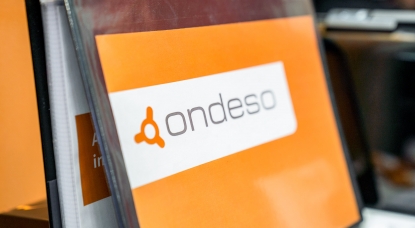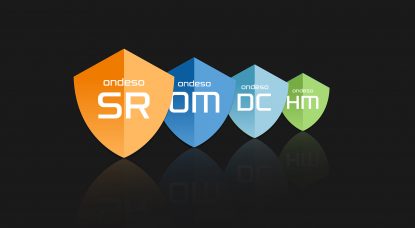Remark: The term OEM (Original Equipment Manufacturer) will be used synonymously in the following for component suppliers, mechanical engineering companies and integrators, as all of them represent the ‘equipment suppliers’ from an operator’s point of view. In practice, many companies have a multiple role/mixed form in the above-mentioned categorization anyway, but this will not be discussed further here, as the focus is on ‘equipment suppliers’ in general.
In the first and second part of this article series you will learn more about the initial situation and the general project structure:
Part 1: ondeso OEM pilot project: Initial Situation of the Equipment Suppliers
Part 2: ondeso OEM pilot project: Structure and Methodology
In this third and last part, the respective use cases and their practical implementation will be presented.

Automatic computer installation and configuration
A recurring process is the computer installation and configuration. The aim was to replace the previously time-consuming manual process at this point and to automate it as far as possible. This should at best eliminate the monotonous and sometimes error-prone manual handling, so that the resources freed up in this way can be used more sensibly elsewhere.
Furthermore, reproducible results should be achieved, which are also completely documented – independent of the executing person. This should also create complete transparency for the customer and enable a clean handover by keeping a kind of ‘file’’ during the entire lifetime of the system in which all changes made are documented. A simple restoration of the delivery status as well as a backup of this status at handover is thus also easily possible.
This was achieved by transferring the necessary program installations and configuration changes into so-called ‘Operations’. In ondeso SR these serve to automate recurring processes and can be seen as reusable modules that can be combined in any way. By combining different operations, a so-called ‘Installation and Configuration Package’ (ICP) is created, which allows the completely automatic assembly of the IT systems.
In close cooperation with the participants’ experts, existing expertise from this area was transferred to the operations and thus also directly documented, improved and optimised in various test runs. In the beginning, virtual machines were used to achieve first results quickly, but the final versions were also tested on the physical target systems.
Automatic inventory of installed software components in the field
A further application should be the often invoked target/actual comparison of machines in the field. As already mentioned, this is only a kind of ‘preliminary stage’ to the planned ‘Online Software Deployment on Demand’, but in itself also represents added value, as deviations can be easily identified and addressed – keyword ‘Self/Risk Assessment’. This example is a good illustration of the difficulty of coordination between manufacturer and operator. After the machine / plant has been delivered from the manufacturer to the operator and all handovers have been completed, it usually also becomes the property of the operator and thus its administrative authority. As a result, the manufacturer typically only gains selective insights into the further handling of the IT components within the machine afterwards, for example when these are checked by the field service during regular maintenance and updated to new program versions if necessary. However, what changes have been made to the system in the meantime usually remains unclear and these pose a corresponding risk for the further support of the system. In some places, for example, operators use virus scanners or install additional tools in order to manage the computers or provide additional security – keyword ‘Application Whitelisting’.
Under these changed conditions, however, the software originally installed on the machine to control the manufacturing process has typically not been tested, and unforeseen complications may arise in daily operation. This may be the case if a production-critical process is targeted by the virus scanner’s pattern update, or if a certain application is not included in the whitelisting but is explicitly required in some situations.
In order to avoid mistakes of this kind, it would of course be interesting for manufacturers to find out what changes were made to the respective systems during their delivery and handover to the operator, so that they can also take these changed conditions into account or at least be informed about them. All too often, however, this lack of information leads manufacturers to prohibit the subsequent modification of the systems completely, under threat of loss of warranty to prevent possible malfunctioning of the machine / system. This in turn, however, sometimes collides with the compliance guidelines of the respective operating companies, according to which each IT component must be secured according to certain minimum standards.
This can be actively counteracted by processing the target/actual status and on this basis, with clear data, concrete solutions can be discussed. Otherwise, there is a risk of platitudes such as ‘nothing has been changed in the system since the last maintenance, but the machine no longer functions properly’.
The goal was achieved by creating a routine in ondeso SR via the already described ‘Operations’ mechanism, which analyzes local files on all machines concerned and reports this information back to the central database, thus providing an overview of the status of all managed devices. If desired, this can also be updated at regular intervals in order to be always informed about possible changes.
Load dependent software distribution
Load dependent software distribution is a step that builds on the target/actual comparison described above. Here, the requirement was to distribute the corresponding files for program updates to all machines under the condition that the transfer itself does not negatively influence the production process. A negative influence would be, for example, the allocation of available bandwidth for the transmission of the update files instead of reserving and using them for the production process itself.
Up to now, such updates have been carried out via removable media during the usual maintenance work on the machine, which, however, followed rather long service intervals. This process should now be improved to the extent that the possible updates are provided in the background and in case of an update request from the operator can already be provided and used on the spot and do not have to be provided at that moment.
Furthermore, due to the lack of knowledge about the software status on the machine, all possible packages were delivered for manual deployment instead of a special selection of those that are really needed. This can now also be taken into consideration and thus both the necessary bandwidth during transmission and the storage space consumption on the target system can be optimized accordingly.
This means that the machine can be updated to the latest software version at any time, if necessary, without having to provide the updates via third-party storage sources beforehand. This allows software technical innovations to be transported to their destination much faster and in a more targeted manner, thus enabling updates to be provided in shorter cycles.

It can be seen from the implemented use cases that practical experience has been gained in a very short time and has led to visible and usable results. The effort involved was manageable in terms of both personnel and costs. It was possible to reduce otherwise personnel-intensive, regular activities, which in turn creates more time and energy for other projects and allows further improvements to the process. During the implementation, a number of technical difficulties were identified, some of which have already been overcome, or at least their consequences can be better assessed and can now be consistently eliminated.
In addition to the generally good introduction to the topic, a certain exchange of experience between the companies has also taken place, which is to be maintained for the future, because ‘we are all in the same boat’.

In conclusion, it can be said that the topic of IT management in industry and especially in mechanical and plant engineering can be assumed, sensible approaches should be clarified and then simply tried out. This has led to consistently positive results and gains in experience. The used methodology of ‘Design Thinking’ has also proven to be a practical tool and allows to approach the very complex topic step by step, so that intermediate successes can be celebrated.
In any case, the conclusion on ondeso’s side is:
It is not an unsolvable task, but rather an exciting challenge. So, let’s start working on it!
HOMAG
HOMAG is the global partner to the woodworking industry with leading machines and plants, complemented by groundbreaking digital solutions. With its modular design and high degree of automation, our product portfolio guarantees future-proof industrial production. Whether entry-level machines or suitable components to supplement the workshop, we accompany carpenters and joiners into a successful future. High-precision machines and state-of-the-art technologies for woodworking companies of all sizes – software and service included.
Goebel
GOEBEL IMS is the worldwide leading supplier of slitter rewinders for converting paper and board, cigarette papers, packaging and industrial films, aluminium foils, aseptic packaging and other special materials. The product range includes slitter rewinders, winders and inspection machines for the manufacturing and converting process as well as inspection and spindle machines for the finishing process. The development and manufacturing took place at the production sites in Germany and Italy.
ondeso
ondeso develops software specifically in the fields industry 4.0 and digitalisation. No matter whether the client is a production company or a machine manufacturer, a medium sized business or a corporate group – ondeso supports them specifically in the field of IT operating management and security in production. The successfully launched products are suited for all industries and applicable across the entire range of production systems and procedures. Whether management systems, HMIs or controls – ondeso manages the lifecycle of industry PCs and offers custom fitted products on the highest technological and conceptual level – 100% made in Germany.

Would you like to learn more? Do not hesitate to contact us, we will be happy to help you.


Here you can learn more about our company and our expertise as a pioneer and market leader.